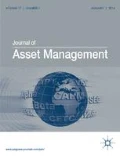Abstract
Exchange-traded Funds (ETFs) have attracted many investors as one of the most innovative products of financial engineering. By virtue of the nascent nature of Islamic ETFs, comparative performance studies of Islamic and conventional ETFs are essential to assess the attractiveness of two distinct financial instruments. By making use of 85 ETFs from UK iShares between 2008 and 2011, this article compares the performance of conventional and Islamic ETFs. In our analysis, the Sharpe, Treynor and Sortino ratios are used as risk-adjusted performance measures. Islamic ETFs can beat both conventional ETFs and the market benchmark index based on risk-adjusted performance measures. Overall, both ETFs were able to outperform the market benchmark index. It is also evident that a portfolio of Islamic ETFs shows less variability and hence is less risky compared with their conventional counterpart. As the existing literature on ETFs generally lacks an empirical analysis of the comparative performance of conventional and Islamic ETFs, this article is a pioneering empirical research on the performance analysis of two distinct types of ETFs, taking samples from the largest provider of ETFs, iShares. The findings of this article are very relevant for investors and fund managers in determining policy matters, deciding investment and marketing strategy for two distinct types of capital market products.

Similar content being viewed by others
References
Alam, N. and Rajjaque, M.S. (2010) Shariah compliant equities-empirical evaluation of performance in European market during credit crunch. Journal of Financial Services Marketing 15 (3): 228–240.
Bernstein, P.J. (2002) A primer on exchange-traded funds. Journal of Accountancy 193 (1): 38–41.
Bernstein, W.J. (2004) It's the execution, Stupid. Efficient Frontier, http://www.efficientfrontier.com/ef/104/stupid.htm, accessed 20 February 2012.
BlackRock. (2011) ETF landscape: Global handbook Q1 2011, http://www2.blackrock.com/ca/en/InstitutionalInvestors/MarketInsight/etflandscape/index.htm, accessed 20 February 2012.
Cao, J. (2005) International Diversification through iShares and Their Rivals. USA: University of Texas at Austin. Working paper.
Carrel, L. (2008) ETFs for the Long Run. Hoboken, NJ: John Wiley & Sons.
Carty, C.M. (2001) ETFs from A to Z: A diversified portfolio can be constructed entirely of ETFs and suitable to any client's risk tolerance. Financial Planning 31 (5): 102–106.
Chang, E. and Swales, G.S. (2003) Do Country-Specific Exchange-Traded Funds Outperform Closed-End Country Funds? USA: SW Missouri State University. Working paper.
Cumby, R. and Glen, J. (1990) Evaluating the performance of international mutual funds. Journal of Finance 45 (2): 497.
Dellva, L.W. (2001) Exchange-traded funds not for everyone. Journal of Financial Planning 14 (4): 110–124.
Deville, L. (2008) Exchange traded funds: History, trading and research. In: C. Zopounidis, M. Doumpos and P. Pardalos (eds.) Handbook of Financial Engineering. Paris, France: Springer, pp. 1–37.
Eun, C.S., Kolodny, R. and Resnick, B.G. (1991) US based international mutual funds: A performance evaluation. Journal of Portfolio Management 17 (3): 88–94.
Ferri, R.A. (2008) The ETF Book. Hoboken, NJ: John Wiley & Sons.
Gardner, R. and Welch, J. (2005) Increasing after-tax return with exchange-traded funds. Journal of Financial Planning 18 (6): 30–35.
Gastineau, G.L. (2001) Exchange-traded funds: an introduction. Journal of Portfolio Management 27 (3): 88–96.
Grinblatt, M. and Titman, S. (1989) Mutual fund performance: An analysis of quarterly holdings. Journal of Business 62 (3): 393–416.
Harper, J.T., Madura, J. and Schnusenberg, O. (2006) Performance comparison between exchange-traded funds and closed-end country funds. Journal of International Financial Markets, Institutions and Money 16 (2): 104–122.
Jensen, M.C. (1968) The performance of mutual funds in the period 1945–64. Journal of Finance 23 (2): 389–416.
Poterba, J.M. and Shoven, J.B. (2002) Exchange-traded funds: a new investment option for taxable investors. American Economic Review 92 (2): 422–427.
Redman, A.L., Gullett, N.S. and Manakyan, H. (2000) The performance of global and international mutual funds. Journal of Financial and Strategic Decisions 13 (1): 75–85.
Sharpe, W.F. (1994) The Sharpe ratio. Journal of Portfolio Management 21 (1): 49–59.
Sortino, F.A. and Robert, V.D.M. (1991) Downside risk. Journal of Portfolio Management 17 (4): 27–32.
Vassal, V.D. (2001) Risk diversification benefits of multiple-stock portfolios. Journal of Portfolio Management 27 (2): 32–39.
Zigler, B. (2002) ETFs finish in first place. Financial Planning 32 (5): 82–85.
Author information
Authors and Affiliations
Corresponding author
Additional information
Disclaimer ‘iShares® and BlackRock® are registered trademarks of BlackRock, Inc. and its affiliates (“BlackRock”). This paper is not sponsored or endorsed by BlackRock. BlackRock is not responsible for the content, accuracy or completeness of any data, for any liability resulting from the use of any data, or for any views expressed in this paper.’
Rights and permissions
About this article
Cite this article
Alam, N. A comparative performance analysis of conventional and Islamic exchange-traded funds. J Asset Manag 14, 27–36 (2013). https://doi.org/10.1057/jam.2012.23
Received:
Revised:
Published:
Issue Date:
DOI: https://doi.org/10.1057/jam.2012.23




